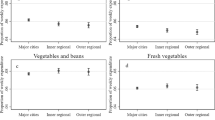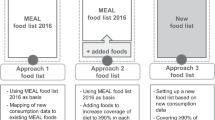Abstract
Objective: To describe the rationale and methods for a European project (EFCOSUM) to develop a method for a European food consumption survey that delivers internationally comparable data on a set of policy-relevant nutritional indicators.
Rationale and methods: Currently Member States are collecting data and information for use at national level. At an international level, such data are often of limited comparability and of varying quality. To promote the development and exchange of adequate, reliable and comparable indicators of public health, and the structures needed to exchange the relevant data, a programme of Community action on health monitoring was set up for the EU. The objective of the action programme is to contribute to the establishment of a Community Health Monitoring System. Data will be made available to all Member States via a telematic network, which is currently being developed for the Health Monitoring Programme.
With regard to nutrition, there is a need for a limited set of policy-relevant dietary indicators that are comparable among EU Member States. In the field of nutrition, however, there is a regrettable lack of internationally comparable data. The project ‘European Food Consumption Survey Method’ (EFCOSUM) therefore aimed to define a (minimum) set of dietary components which are relevant determinants of health and to define a method for the monitoring of food consumption in nationally representative samples of all age–sex categories in Europe in a comparable way. The project was carried out by 14 Member States as well as nine other European countries. Activities of the project included plenary sessions, desk research, and working group activities, building on existing experience from such projects as DAFNE, EPIC, FLAIR Eurofoods-Enfant project, COST Action 99 and others. The proposed method may be used alone, or as a calibration method to accompany existing ongoing studies.
Sponsorship: European Commission, DG SANCO F/3, Health Monitoring Programme.
This is a preview of subscription content, access via your institution
Access options
Subscribe to this journal
Receive 12 print issues and online access
$259.00 per year
only $21.58 per issue
Buy this article
- Purchase on Springer Link
- Instant access to full article PDF
Prices may be subject to local taxes which are calculated during checkout
Similar content being viewed by others
Author information
Authors and Affiliations
Consortia
Corresponding author
Rights and permissions
About this article
Cite this article
Brussaard, J., Johansson, L., Kearney, J. et al. Rationale and methods of the EFCOSUM project. Eur J Clin Nutr 56 (Suppl 2), S4–S7 (2002). https://doi.org/10.1038/sj.ejcn.1601422
Published:
Issue Date:
DOI: https://doi.org/10.1038/sj.ejcn.1601422
Keywords
This article is cited by
-
Comparison of food consumption and nutrient intake assessed with three dietary assessment methods: results of the German National Nutrition Survey II
European Journal of Nutrition (2019)
-
The added value of food frequency questionnaire (FFQ) information to estimate the usual food intake based on repeated 24-hour recalls
Archives of Public Health (2017)
-
The standardized computerized 24-h dietary recall method EPIC-Soft adapted for pan-European dietary monitoring
European Journal of Clinical Nutrition (2011)
-
Biomarker-based evaluation of two 24-h recalls for comparing usual fish, fruit and vegetable intakes across European centers in the EFCOVAL Study
European Journal of Clinical Nutrition (2011)
-
Use of a common food frequency questionnaire (FFQ) to assess dietary patterns and their relation to allergy and asthma in Europe: pilot study of the GA2LEN FFQ
European Journal of Clinical Nutrition (2011)



